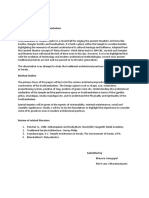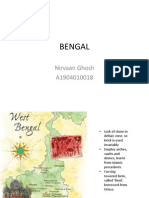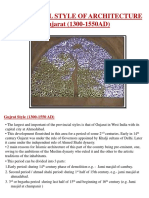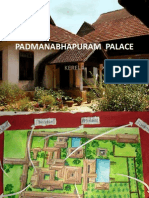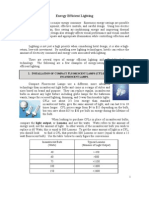Professional Documents
Culture Documents
Krishnapuram Palace, Kayamkulam
Uploaded by
Rayan50%(2)50% found this document useful (2 votes)
755 views9 pagesThe Krishnapuram Palace was built in the 18th century by the Travancore kingdom as a palace and museum located in Kayamkulam, Kerala. It is built in the architectural style of Kerala with gabled roofs, narrow corridors, and dormer windows. The palace complex originally encompassed 56 acres but has been reduced to 2.55 acres. It was renovated by the Archaeological Department of Kerala in the 1950s and now houses exhibits from the palace as well as the largest known mural painting in Kerala titled "Gajendra Moksham".
Original Description:
Original Title
krishnapuram-1
Copyright
© © All Rights Reserved
Available Formats
PPTX, PDF, TXT or read online from Scribd
Share this document
Did you find this document useful?
Is this content inappropriate?
Report this DocumentThe Krishnapuram Palace was built in the 18th century by the Travancore kingdom as a palace and museum located in Kayamkulam, Kerala. It is built in the architectural style of Kerala with gabled roofs, narrow corridors, and dormer windows. The palace complex originally encompassed 56 acres but has been reduced to 2.55 acres. It was renovated by the Archaeological Department of Kerala in the 1950s and now houses exhibits from the palace as well as the largest known mural painting in Kerala titled "Gajendra Moksham".
Copyright:
© All Rights Reserved
Available Formats
Download as PPTX, PDF, TXT or read online from Scribd
50%(2)50% found this document useful (2 votes)
755 views9 pagesKrishnapuram Palace, Kayamkulam
Uploaded by
RayanThe Krishnapuram Palace was built in the 18th century by the Travancore kingdom as a palace and museum located in Kayamkulam, Kerala. It is built in the architectural style of Kerala with gabled roofs, narrow corridors, and dormer windows. The palace complex originally encompassed 56 acres but has been reduced to 2.55 acres. It was renovated by the Archaeological Department of Kerala in the 1950s and now houses exhibits from the palace as well as the largest known mural painting in Kerala titled "Gajendra Moksham".
Copyright:
© All Rights Reserved
Available Formats
Download as PPTX, PDF, TXT or read online from Scribd
You are on page 1of 9
+++++++++++++++++++++++++
+++++++++++++++++++++++++
+++++++++++++++++++++++++
+++++++++++++++++++++++++
+++++++++++++++
Krishnapuram Palace, Kayamkulam
• The Krishnapuram Palace is a palace and museum located
in Kayamkulam near Alappuzha in Alappuzha district, Kerala in
southwestern India.
• It was built in the 18th century by Anizham Thirunal Marthanda Varma (1729–
1758 AD), the Travancore kingdom.
• It is built in the architectural style of Kerala with gabled roof, narrow corridor
and dormer windows, near the Krishnaswamy Temple at Krishnapuram
• The palace is maintained by the Archaeological Department of Kerala and
contains exhibits that belonged to the Palace and its former occupant, the
Travancore Maharaja Marthanda Varma.
• It is also famous for a large pond within the palace complex. It is also said that
an underground escape route runs from the bottom of the pond as a possible
escape route from enemies
• Among the many Kerala-style paintings seen in the palace, a distinctly placed
mural painting is titled "Gajendra Moksham" of 154 square feet (14.3 m2) size,
which is said to be the largest such find in Kerala. It is placed on the western
end of the ground floor of the palace
• The palace was built by King Marthanda Varma .
• Before the construction of the palace, the King demolished an earlier palace at
the site, which had been built by the King Veera Ravi Varma of Odanad (reign
1700–1775 AD).
• Initially, a small palace of a single story, known locally as Ettukettu, was built in
the traditional style with an adjacent pond, temple and urappura under the
management of Prime Minister Ramayyan Dalawa, which was later enlarged by
Prime Minister Ayyappan Marthanada Pillai.
• The palace complex has many other buildings, which are a combination
of traditional and Western architecture.
• The present building, a three-storied structure within the complex, was
renovated in the 1950s by the Archaeological Department of Kerala in modern
style conforming to the scientific techniques prescribed for the protection of
heritage buildings.
The Krishnapuram Palace, as one of the finest and rarest examples of a typical
Keralite-style architecture, known in the local language as Pathinerakettu, is
complete with gabled roofs, narrow corridors and dormer windows. It is a miniature
replica of Padmanabhapuram Palace, which was the headquarters of Travancore
Rajas.
• The palace complex originally encompassed a total land area of 56 acres
(23 ha). However, over the years, as the monarchic rule ended, the palace was
completely neglected and fell to disuse, and was dilapidated.
• Many of the buildings surrounding the main palace of the Maharaja got
demolished or destroyed and the palace complex got reduced to a mere 2.55
acres (1.03 ha) enclosed within a 10 feet (3.0 m) high compound wall.
• The main palace, which was run down, was rebuilt to its original state as a three
storied monument by the Archaeological Department of Kerala in the 1950s.
• The rare documents and artefacts which were kept at other locations were
brought back, restored and eventually exhibited in the palace that has been
converted into a Museum
• The palace restored to its originally built plans, conforming to Vastu
Shastra norms, has 16 blocks or Kettus with four Nadumuttam or open area in
the centre or courtyards.
• The windows, doors and ventilators were placed in such a way as to ensure
fresh air circulation and natural lighting in all the rooms.
• There are 22 rooms (which open into the shady internal courtyards) with
ornamental wooden partitions with carvings.
• The building is set with verandas (passages) all round to protect the outer walls
getting damaged due to rains
• The materials used in its construction consisted of laterite stones, rubble,
teak, rosewood and Angili wood.
Roofing (red-tiled gabled) is steep and tiled with Mangalore tiles, which
accentuates the beauty of the structure.
A special feature of the carpentry adopted in building the palace consisted of
wooden hinges and locks for doors and windows, instead of metallic fittings and
fixtures.
The flooring consists of polished wood and also of black and red oxide-coated
concrete. The steps are made of polished granite blocks
A small stream was created to flow close to the southern vicinity of the palace
which also functioned as a secret escape route in times of emergency.
An underground tank or pond that stretches to the centre of the building was part
of the palace; it provided air-conditioning effect of moderate temperature in all
interior rooms.
The palace compound has many Padippuras, particularly at the main entrance,
which are significators of status.
• Within the palace is the archaeological museum which has an exhibit of
the Gajendra Moksham a 3 metres (9.8 ft) high mural, which is the largest
single piece of mural painting so far discovered in Kerala.
• The literal meaning of 'Gajendra Moksham' is the "salvation orMoksha of the
elephant king Gajendra."
• The theme of the mural is mythological and depicts an elephant saluting Lord
Vishnu in devotion while the other minor gods, goddesses and saints look on.
Lord Vishnu was the family deity of the Kayamkulam Kings.
• This mural, in a fusion of colours and expressions, was placed prominently at
the entrance to the palace from the pond to enable the kings to worship the
deity after their daily ablutions
You might also like
- Padmanabhampurampalace 100211074034 Phpapp01Document13 pagesPadmanabhampurampalace 100211074034 Phpapp01surekaNo ratings yet
- Keralaarchitecture 151005035817 Lva1 App6891Document42 pagesKeralaarchitecture 151005035817 Lva1 App6891atif ali khan100% (2)
- Vernacular Architecture of TripuraDocument26 pagesVernacular Architecture of TripuraAjjit SinglaNo ratings yet
- Dissertation Synopsis - An Empirical Study On KoothambalamsDocument1 pageDissertation Synopsis - An Empirical Study On KoothambalamsBhasuraVenugopalNo ratings yet
- Evolution of Tombs in IndiaDocument25 pagesEvolution of Tombs in IndiaSumit Sharma100% (1)
- Hawa Mahal: THE Palace OF WindsDocument5 pagesHawa Mahal: THE Palace OF WindsFathimaNo ratings yet
- BengalDocument31 pagesBengalnirvaangNo ratings yet
- Kerala Architecture - A Case StudyDocument108 pagesKerala Architecture - A Case StudyDhwani AsharNo ratings yet
- Artist's ResidenceDocument23 pagesArtist's ResidenceSahitya H MNo ratings yet
- Uttam JainDocument18 pagesUttam JainyashaswiniNo ratings yet
- Christopher Charles Benninger: Amarnath Ps 2018BARC021Document18 pagesChristopher Charles Benninger: Amarnath Ps 2018BARC021AMARNATH PS0% (1)
- Pondicherry PDFDocument7 pagesPondicherry PDFHoney Dave100% (1)
- Mandir Shri RamchandrajiDocument6 pagesMandir Shri RamchandrajiGitika SenNo ratings yet
- PSP Charles Correa - Kanchanjunga ApartmentsDocument11 pagesPSP Charles Correa - Kanchanjunga ApartmentsPankaj DhakedNo ratings yet
- Hawa MahalDocument2 pagesHawa MahalAnnabeth100% (1)
- Case Study: Paliyam NalukettuDocument24 pagesCase Study: Paliyam NalukettuTushar KNo ratings yet
- Krishna (Hasan Fathy)Document15 pagesKrishna (Hasan Fathy)Ankur SharmaNo ratings yet
- Laurie Baker PresentedDocument33 pagesLaurie Baker PresentedArnav DasaurNo ratings yet
- Vadakunnathan Temple: Trissur, KeralaDocument19 pagesVadakunnathan Temple: Trissur, KeralaHareesh HaridasanNo ratings yet
- Presentation 1Document2 pagesPresentation 1Paul AugustineNo ratings yet
- Natrani AmphitheaterDocument10 pagesNatrani AmphitheaterA-07 MIHIR BHUVANo ratings yet
- Revival of Indian Architecture Under British PatronageDocument21 pagesRevival of Indian Architecture Under British PatronagevijayaratnaNo ratings yet
- IIM Kozhikode Campus PDFDocument1 pageIIM Kozhikode Campus PDFm aNo ratings yet
- Uttam C Jain-1Document6 pagesUttam C Jain-1SuryNo ratings yet
- Triplicane 2 - 0 PDFDocument15 pagesTriplicane 2 - 0 PDFVijay VNo ratings yet
- Lodi Gardens: Saumya Wadhwa B.ARCH 3 (B) Vastukala AcademyDocument12 pagesLodi Gardens: Saumya Wadhwa B.ARCH 3 (B) Vastukala AcademyAbhishek RawatNo ratings yet
- Capitol ComplexDocument12 pagesCapitol ComplexvporechaNo ratings yet
- U.C. JainDocument2 pagesU.C. JainNikita ChoudharyNo ratings yet
- Jami MasjidDocument9 pagesJami MasjidAnsif K HabibNo ratings yet
- El-Guadual Early Youth Development CenterDocument24 pagesEl-Guadual Early Youth Development Centerjaz100% (1)
- Steeltrusses 170323101523Document22 pagesSteeltrusses 170323101523Mohan SaragadamNo ratings yet
- Presentation 1Document11 pagesPresentation 1Rahul ChandraNo ratings yet
- Manassas Park Case Study 1Document9 pagesManassas Park Case Study 1Koco TomeskiNo ratings yet
- Provincial Gujarat Style PDFDocument26 pagesProvincial Gujarat Style PDFSumit SharmaNo ratings yet
- Eco-Village at Naugarh, Siddharthnagar: Project Overview Good Earth Malhar-FootprintsDocument11 pagesEco-Village at Naugarh, Siddharthnagar: Project Overview Good Earth Malhar-FootprintsArshi KhanNo ratings yet
- Habib RahmanDocument23 pagesHabib RahmanAkshay KumarNo ratings yet
- bIDAR 1Document62 pagesbIDAR 1Deepak PatelNo ratings yet
- Case Study Management InstituteDocument30 pagesCase Study Management InstituteParidhi Goel100% (1)
- Charles CorreaDocument15 pagesCharles Correaankitha100% (1)
- Gandhi Museum AHMEDABAD PPT by UshmaDocument6 pagesGandhi Museum AHMEDABAD PPT by UshmaUTMC100% (1)
- Presentation ON Ar. Romi Khosla: Presented By: Harshita RanaDocument18 pagesPresentation ON Ar. Romi Khosla: Presented By: Harshita RanaHarshita RanaNo ratings yet
- Name:T.Gnanender Reddy ROLL NO:1841303109 Course:B.Sc 3 Year Collage:Ihm Shri ShaktiDocument20 pagesName:T.Gnanender Reddy ROLL NO:1841303109 Course:B.Sc 3 Year Collage:Ihm Shri ShaktiJashwanth RelangiNo ratings yet
- Critical Appraisal Jami MAsjidDocument13 pagesCritical Appraisal Jami MAsjidHashim Muhammed100% (1)
- Charles Correa: Nationality-Indian Born-1Document24 pagesCharles Correa: Nationality-Indian Born-1a4104165No ratings yet
- Patwon Ki Haveli: Saravana Kumar Sivakumar Sandoshivan Ayesha AfreenDocument16 pagesPatwon Ki Haveli: Saravana Kumar Sivakumar Sandoshivan Ayesha AfreenManisha Mary ThomasNo ratings yet
- Twa Structural AnalysisDocument24 pagesTwa Structural Analysisvishnu kapadiaNo ratings yet
- JaisalmerDocument3 pagesJaisalmerNagpal ChetanNo ratings yet
- Indocolonial Architecture ChennaiDocument29 pagesIndocolonial Architecture ChennaiAbhishek AcharyaNo ratings yet
- Humayun's TombDocument17 pagesHumayun's TombShivamNo ratings yet
- Cube and Hemisphere of The Muslim TombDocument9 pagesCube and Hemisphere of The Muslim TombMurshed Ahmed100% (1)
- Travelator (Moving Walkway) Escalator Elevator: What Is Shopping Mall?Document4 pagesTravelator (Moving Walkway) Escalator Elevator: What Is Shopping Mall?Rhythm SatyaNo ratings yet
- Pondicherry FinalDocument23 pagesPondicherry FinalK LAVANYANo ratings yet
- 2 Goa State MuseumDocument1 page2 Goa State MuseumSUSHMITANo ratings yet
- Laurie Baker: Contemporary ArchitectureDocument22 pagesLaurie Baker: Contemporary ArchitecturePrakruthi Prashanth100% (1)
- Engineers India HouseDocument6 pagesEngineers India HouseDees_24100% (2)
- Mysore Palace Architectural Case StudyDocument18 pagesMysore Palace Architectural Case StudyArkodeep Sen67% (3)
- Pattadakal TemplesDocument2 pagesPattadakal TemplesOmungNo ratings yet
- Health ManagementDocument10 pagesHealth Managementpurvakul10No ratings yet
- Padmanabhapuram PalaceDocument14 pagesPadmanabhapuram Palacesuryasooriyamoorthy100% (1)
- Sociology & EconomicsDocument12 pagesSociology & EconomicsRayanNo ratings yet
- Shahrukh KhanDocument22 pagesShahrukh KhanNaresh Adhikari100% (4)
- Krishnapuram Palace, KayamkulamDocument9 pagesKrishnapuram Palace, KayamkulamRayan50% (2)
- PADMANABHAPURAMDocument23 pagesPADMANABHAPURAMRayanNo ratings yet
- Fire Safety of BuildingsDocument55 pagesFire Safety of BuildingsRayanNo ratings yet
- 5 Motivational and Inspiring Short StoriesDocument40 pages5 Motivational and Inspiring Short StoriesPalabPalaniNo ratings yet
- Kerala Poilice Act-Uploaded by T James Joseph Adhikarathil, Kumaranalloor, Kottayam, Kerala (Deputy Collector (LR) Alappuzha)Document73 pagesKerala Poilice Act-Uploaded by T James Joseph Adhikarathil, Kumaranalloor, Kottayam, Kerala (Deputy Collector (LR) Alappuzha)James AdhikaramNo ratings yet
- ChartersDocument54 pagesChartersAngel Chrys100% (1)
- Types of Lamps: SubtitleDocument41 pagesTypes of Lamps: SubtitleRayanNo ratings yet
- MCB and ElcbDocument8 pagesMCB and ElcbRayanNo ratings yet
- Switch GearDocument8 pagesSwitch GearRayanNo ratings yet
- 10 Survival Tips For Architecture Students - The Life of A DesignerDocument5 pages10 Survival Tips For Architecture Students - The Life of A DesignerRayanNo ratings yet
- Electrical Substation General EquipmentsDocument18 pagesElectrical Substation General EquipmentsRayanNo ratings yet
- Different Types of Wiring Systems and Methods of Electrical WiringDocument11 pagesDifferent Types of Wiring Systems and Methods of Electrical WiringRayanNo ratings yet
- S6 CALICUT UNIVERSITY BARCH Question PapersDocument30 pagesS6 CALICUT UNIVERSITY BARCH Question PapersRayanNo ratings yet
- Electrical Substation General EquipmentsDocument18 pagesElectrical Substation General EquipmentsRayanNo ratings yet
- Japanese Garden: Submitted By-Minhaz Yusuf Muhammed FasilDocument14 pagesJapanese Garden: Submitted By-Minhaz Yusuf Muhammed FasilRayanNo ratings yet
- Captive Power PlantDocument1 pageCaptive Power PlantRayanNo ratings yet
- Japanese Garden: Submitted By-Minhaz Yusuf Muhammed FasilDocument14 pagesJapanese Garden: Submitted By-Minhaz Yusuf Muhammed FasilRayanNo ratings yet
- Architectural Top ModelsDocument100 pagesArchitectural Top ModelsRayanNo ratings yet
- Stair FinishesDocument5 pagesStair FinishesRayanNo ratings yet
- CIS EO Lighting 167401 7Document7 pagesCIS EO Lighting 167401 7luisgunNo ratings yet
- By Hashir Hanan & ZiyadhDocument9 pagesBy Hashir Hanan & ZiyadhRayanNo ratings yet
- Balance - THEORY OF DESIGNDocument14 pagesBalance - THEORY OF DESIGNRayanNo ratings yet
- Coastal Zone: - Open SeaDocument3 pagesCoastal Zone: - Open SeaRayanNo ratings yet
- Water SupplyDocument50 pagesWater SupplyRayan100% (1)
- Waste Land, ReclamationDocument30 pagesWaste Land, ReclamationRayanNo ratings yet
- Environmental Studies - Module 1Document23 pagesEnvironmental Studies - Module 1RayanNo ratings yet
- 12 Tips For Making An Outstanding Architecture Portfolio - ArchDailyDocument10 pages12 Tips For Making An Outstanding Architecture Portfolio - ArchDailyRayanNo ratings yet
- Ducati WiringDocument7 pagesDucati WiringRyan LeisNo ratings yet
- Credit CardDocument6 pagesCredit CardJ Boy LipayonNo ratings yet
- Spring 12 ECON-E370 IU Exam 1 ReviewDocument27 pagesSpring 12 ECON-E370 IU Exam 1 ReviewTutoringZoneNo ratings yet
- Chapter 3 Depreciation - Sum of The Years Digit MethodPart 4Document8 pagesChapter 3 Depreciation - Sum of The Years Digit MethodPart 4Tor GineNo ratings yet
- DR Afwan Fajri - Trauma - Juli 2023Document82 pagesDR Afwan Fajri - Trauma - Juli 2023afwan fajriNo ratings yet
- Annex A - Scope of WorkDocument4 pagesAnnex A - Scope of Workمهيب سعيد الشميريNo ratings yet
- Adsorption ExperimentDocument5 pagesAdsorption ExperimentNauman KhalidNo ratings yet
- Mongodb TutorialDocument106 pagesMongodb TutorialRahul VashishthaNo ratings yet
- NCDC-2 Physical Health Inventory Form A4Document6 pagesNCDC-2 Physical Health Inventory Form A4knock medinaNo ratings yet
- Motion To Dismiss Guidry Trademark Infringement ClaimDocument23 pagesMotion To Dismiss Guidry Trademark Infringement ClaimDaniel BallardNo ratings yet
- Performance Evaluation of The KVM Hypervisor Running On Arm-Based Single-Board ComputersDocument18 pagesPerformance Evaluation of The KVM Hypervisor Running On Arm-Based Single-Board ComputersAIRCC - IJCNCNo ratings yet
- PEA Comp Study - Estate Planning For Private Equity Fund Managers (ITaback, JWaxenberg 10 - 10)Document13 pagesPEA Comp Study - Estate Planning For Private Equity Fund Managers (ITaback, JWaxenberg 10 - 10)lbaker2009No ratings yet
- International Business ManagementDocument3 pagesInternational Business Managementkalaiselvi_velusamyNo ratings yet
- Carbonate Platform MateriDocument8 pagesCarbonate Platform MateriNisaNo ratings yet
- PUPiApplyVoucher2017 0006 3024Document2 pagesPUPiApplyVoucher2017 0006 3024MätthëwPïńëdäNo ratings yet
- ARTS10 Q2 ModuleDocument12 pagesARTS10 Q2 ModuleDen Mark GacumaNo ratings yet
- Engine Stalls at Low RPM: Diagnostic CodesDocument3 pagesEngine Stalls at Low RPM: Diagnostic CodesAmir Bambang YudhoyonoNo ratings yet
- Crusader Castle Al-Karak Jordan Levant Pagan Fulk, King of Jerusalem MoabDocument3 pagesCrusader Castle Al-Karak Jordan Levant Pagan Fulk, King of Jerusalem MoabErika CalistroNo ratings yet
- Poka-Yoke or Mistake Proofing: Historical Evolution.Document5 pagesPoka-Yoke or Mistake Proofing: Historical Evolution.Harris ChackoNo ratings yet
- 5000-5020 en PDFDocument10 pages5000-5020 en PDFRodrigo SandovalNo ratings yet
- 5G NR Essentials Guide From IntelefyDocument15 pages5G NR Essentials Guide From IntelefyUzair KhanNo ratings yet
- Note Hand-Soldering eDocument8 pagesNote Hand-Soldering emicpreampNo ratings yet
- General Characteristics of Phonemes: Aspects of Speech SoundsDocument8 pagesGeneral Characteristics of Phonemes: Aspects of Speech SoundsElina EkimovaNo ratings yet
- Southern California International Gateway Final Environmental Impact ReportDocument40 pagesSouthern California International Gateway Final Environmental Impact ReportLong Beach PostNo ratings yet
- USTH Algorithm RecursionDocument73 pagesUSTH Algorithm Recursionnhng2421No ratings yet
- Earth and Life Science, Grade 11Document6 pagesEarth and Life Science, Grade 11Gregorio RizaldyNo ratings yet
- CNC - Rdmacror: Public Static Extern Short Ushort Short Short ShortDocument3 pagesCNC - Rdmacror: Public Static Extern Short Ushort Short Short ShortKession HouNo ratings yet
- Chapter 2Document69 pagesChapter 2Lizi CasperNo ratings yet
- PP Checklist (From IB)Document2 pagesPP Checklist (From IB)Pete GoodmanNo ratings yet
- NHL DB Rulebook ENGLISHDocument6 pagesNHL DB Rulebook ENGLISHAdhika WidyaparagaNo ratings yet




